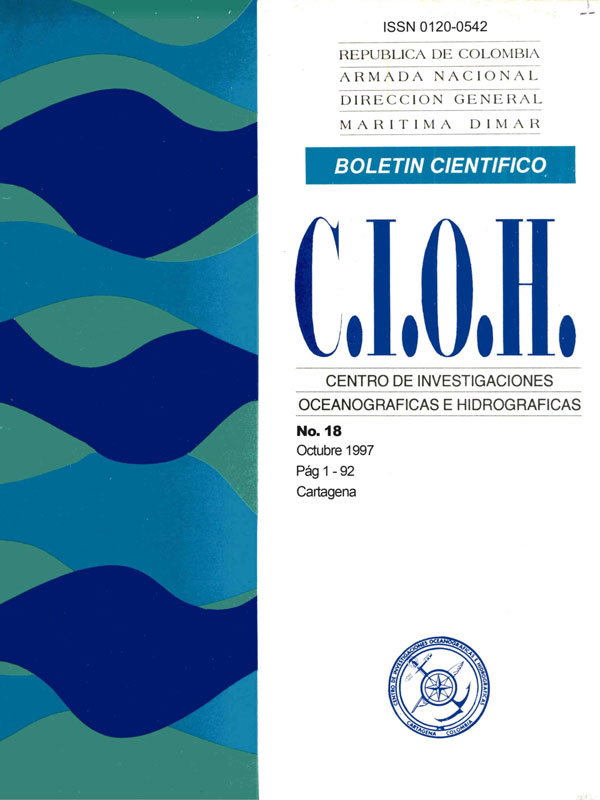Influencia de los aportes de materia orgánica externa y autóctona en el decrecimiento de los niveles de oxigeno disuelto en la Bahía de Cartagena, Colombia
DOI:
https://doi.org/10.26640/22159045.88Keywords:
Cartagena, pollutans, dissolved oxygen, ecosystemsAbstract
On this article the seasonal variations of disolved oxygen in the Bay of Cartagena from february 1996 thru April 1997 are presented. One of the most outstanding results is identifying of the external and the local sources of contamination affecting the Bay of Cartagena, and the &verse pollutans They carry with them, amont which organic matter produced by such sources which represents one of the most important, sin ce it affects directly one of the basic parameters for marine 11 fe such as dissolved oxygen, crea ting zones lacking in oxygen con tent at the bottom of the Bay, especially during the rainy season.
In general terms, the main sources of contamination affecting the bay in order of Importance due to their organic load, considering the of lack of oxygen found at the bottom, are the waters of the sewage system and the bentonic demand. Al] efforts of the city to recover the ecosystems of the bay must concentrate on this two causes.
Downloads
References
Bowman, G.T. y J.J. Delfino, Secliment Oxygen Dernand Thecniques a Review and Comparison of Laboratory and in situ Sistems. Water Research, 14: 491-499, 1980.
CARDIQUE. Informe Preliminar sobre Contaminación de Fuentes Industriales a la Bahía de Cartagena. Cartagena Sin Publicar. 1996.
CEPAL. Plan Básico para la Gestión Ambiental del Distrito de Cartagena de Indias, Cartagena, Colombia. 117p. Informe. 1992.
Consultores Generales Asociados. Estudio Integral del Control de la Contaminación de la Bahía de Cartagena y sus Areas de Influencia. CRPDNB. FONADE. Tomos 1 y 11. Cartagena. 1983.
Davies, D. y R.I. Vance, Determination of Dissolved Oxygen. Chemistry, 48(2). pp: 25-28. 1975
Garay, T. J. A. y M.E.A. Jurado, Contribución al Estudio Oceanográfico Químico de la Bahía de Cartagena. Tesis de Grado. Dpto de Química. Universidad Nacional de Colombia. DIMAR/ CIOH. Bogotá. 1981.
Garay, T. J. A. Manual de Técnicas Analíticas de Parámetros Fisicoquímicos y Contaminantes Marinos. DIMAR/C1OH/CCO/Fundación Mamona'. Bogotá. 109p, 1993.
Garay, T. J. A., Estado actual de los Muelles del Puerto de Cartagena en cuanto a facilidades de Recepción de Residuos provenientes de buques de acuerdo a MARPOL 73-78. Bol. Cient. CIOH No. 14. pp: 47-66. 1993.
Garay, T.J.A. Estimación de los Residuos Oleosos y Basuras Provenientes de los Buques en el Puerto de Cartagena de Indias. Estudio Preliminar sobre Instalaciones de Recepción Necesarias. Cartagena. 70p, 1995.
Garay, T.J.A. Informe Final Proyecto "Contaminación por Hidrocarburos, Plaguicidas y Eutroficadón en Lagunas Costeras del Caribe Colombiano". Fase II - Cuerpos de Agua de Cartagena. CIOH. 1996.
IDEADE. Cartagena Ambiente y Desarrollo. Consideraciones para una Gestión Integral. Universidad Javeriana-Colcienclas-OEA, Bogotá. 110p. 1993.
Memorias Seminario - Taller. Desarrollo Ambiental de Cartagena. Pontificia-Universidad Javeriana-Colcienclas-OEA. 429 p. 1992.
Ivannof, A. lntroduction a L'Oceanographye. Tome I. París. 19p. 1972.
Ministerio de Salud. Disposiciones Sanitarias sobre Aguas. Decreto 1594 de 984. 100p. 1984.
Pagilardini, J. L., Síntesis Proyecto Bahía de Cartagena. Bol. Cient Cartagena.. 70p, 1995. CIOH No. 4. 1982. 79 pp. Cartagena.
Riley, J.P. y G. Skirrow. Chemical Oceagraphy. Academie Press. 2a. Edición. p- 1-3C 1965.
Schaus, R.H. Circulación y Transporte del Agua en la Bahía de Cartagena de Indias Mediante su Representación por el Modelo Hidrodinárnico Numérico de Circulación. División de Oceanografía: Armada Nacional. Bogotá. 49p. 1974.
Urueta y Piñeres. Cartagena y sus Alrededores. Editorial Mogollón.50p. 1912.
Downloads
Published
Issue
Section
License
Attribution — You must give appropriate credit, provide a link to the license, and indicate if changes were made. You may do so in any reasonable manner, but not in any way that suggests the licensor endorses you or your use.
NonCommercial — You may not use the material for commercial purposes.
NoDerivatives — If you remix, transform, or build upon the material, you may not distribute the modified material.
No additional restrictions — You may not apply legal terms or technological measures that legally restrict others from doing anything the license permits.



